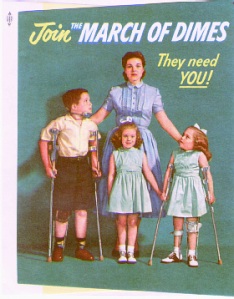Person: Dr. Jonas Salk

Salk's discovery made him a genuine American hero. Uploaded by meisenproductions.com.
We often hear winter called the cold and flu season. But in post-World War II America, summer was the season of fear. Summer was the season of polio, a disease that at its peak in 1952 affected nearly 60,000 children, and killed 3,000. Many of those who survived were crippled.
Jonas Salk accepted the challenge to find a vaccine for the disease. He worked in his virology laboratory at the University of Pittsburgh for eight years, getting closer and closer to finding the solution to the deadly puzzle.

Uploaded by nlm.nih.gov.
The March of Dimes, a charity established to help fund polio research, liked what it saw in Salk’s work and helped fund it. That funding, along with a discovery by John Enders of how to keep polio alive in the lab for research purposes, gave Salk the tools he needed to complete his discovery.
He was hailed as a hero when his vaccine was first announced in 1955. Children were immunized, polio was halted, and the polio panic abated. Another researcher, Albert Sabin, was simultaneously coming up with another vaccine that could be taken orally, but it was Salk’s discovery that was announced first, and children received his shots a couple of years before they took Sabin’s sugar cubes.

Uploaded by marshfield.coos-bay.k12.or.us.
One of the most remarkable things about Jonas Salk was that he didn’t patent his discovery. He realized how urgently the medicine was needed and that lives would be lost during the patent application and approval process. Suppose someone came up with a vaccine for AIDS tomorrow – would such a personal sacrifice even be considered? To ask the question is to know the answer.
[youtube=http://www.youtube.com/watch?v=6LTvhIR-Vz4&hl=en&fs=1&]
